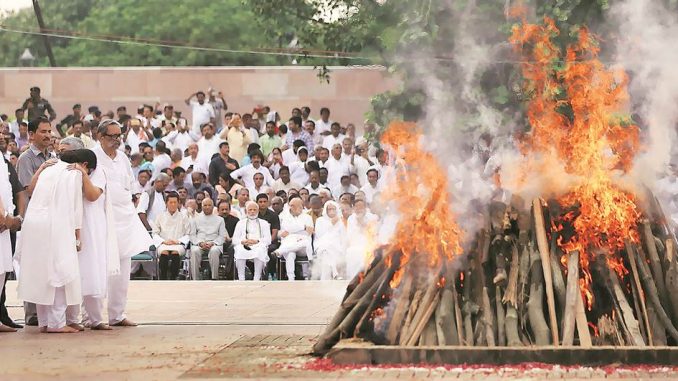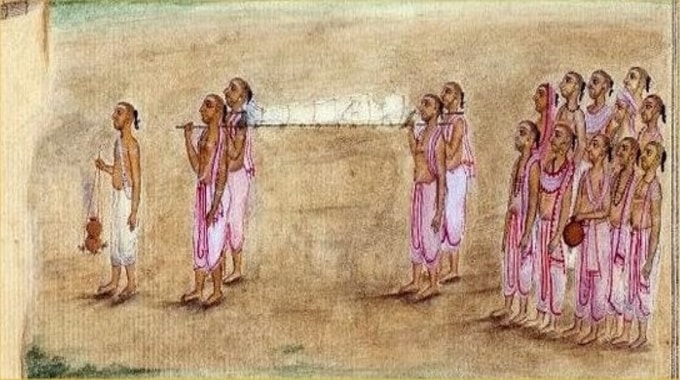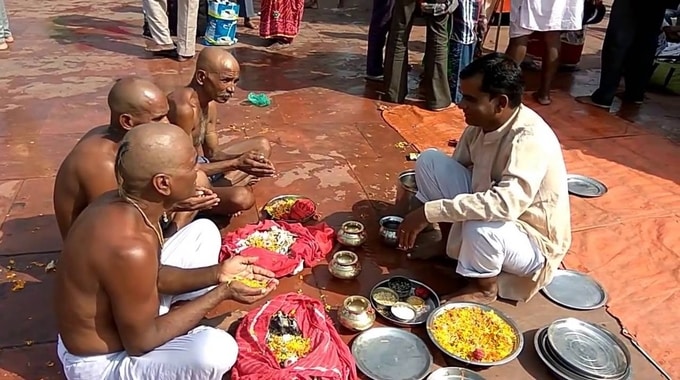
The greatness of Indian culture is evident in the lifestyle and traditions of its people. Sixteen rites are also an inherent part of the lifestyles practiced by India and its people. With the tide of time, there were also changes in sixteen rites. According to the Vedic traditions, the first sacrament is the conception of the conception (conceiving a child) and the last is the funeral (funeral). Birth and death are eternal truths and their existence cannot be denied by anyone. Funeral rites are celebrated when a person’s soul leaves their body. It is also known as cremation in Hinduism. It is known by different names in other religions. The ceremony is conducted by the relatives of the deceased person. Each ritual performed during this rite has special significance. Rite rituals are remembered both religiously and scientifically. Nowadays, most people burn the dead body between only a few wood and perform the last rites.
Importance of Antyeshti Sanskar in Hinduism
The funeral is the last rites according to Hinduism. According to the scriptures, it is believed that the unfulfilled wishes of the deceased are pacified when the last rites are duly performed without any lapse. The departed soul leaves behind every wish and imagination and starts traveling to the other side. During this time, only the ‘body’ is cremated according to the rites and rituals.
The significance of this rite is described in the ‘Bodhayan Pitru Medha Sutra’. It is called;
“जातसंस्कारैणेमं लोकमभिजयति मृतसंस्कारैणामुं लोकम्।”
This means that with the remembrance of other sacrament ceremonies, a person regains control of this world and with the help of funeral rites, a person also conquers another world (heaven).
It is mentioned in another verse,
“तस्यान्मातरं पितरमाचार्य पत्नीं पुत्रं शि यमन्तेवासिनं पितृव्यं मातुलं सगोत्रमसगोत्रं वा
दायमुपयच्छेद्दहनं संस्कारेण संस्कृर्वन्ति।।”
Which means that when your relatives and acquaintances are dead, you should perform the last rites of the corpse by duly inspecting all the rites and rituals.
Things to Remember Before Conducting the Antyeshti Funeral Ritual
- New clothes, bedding, bed sheets and mattresses should be brought for the deceased.
- Flowers should be brought for the decoration of the death bed.
- Materials such as barley flour, sesame and rice should be mixed and kept ready for mass donation. If barley flour is not available, then wheat flour should be mixed with barley.
- Arrange the holy fire or fire from home or at the crematorium.
- Arrange the ingredients required for Aarti such as Thali, Roli, Akshat, Agarbatti and matchsticks.
- The essential ingredients for Havan such as sandalwood, incense sticks, dry basil leaves should be kept ready.
- For the final prasad, add ghee inside a coconut after piercing its shell.
Cremating the Dead: Rituals to Follow
Apply cow dung to the walls. After that, the dead person’s body should be washed with Ganga water while chanting “ॐ आपोहिष्ठा / oṃ āpohiṣṭhā”.
After washing, put new clothes on the dead. The body should be decorated with flowers and sandalwood while chanting,
“ॐ यमाय सोमं नुनुत, यामाय जुहुता हविः।
यमं ह यज्ढो गच्छति, अग्निदूतो अरंकृतः।।” …..ऋ 10.14.13
The person who has done the responsibility should sit facing south. After purifying themselves, they should keep intact, flowers and water on their hands and take an oath reciting the following mantra,
“……….नामाऽहं (मृतक का नाम) प्रेतस्य प्रेतत्त्व – निवृत्त्या उत्तम लोक प्राप्त्यर्थं औधर्वदेहिकं करिष्ये।”
Procedures to Start the Shav Yatra
- After swearing, one should donate the body first.
- Pick up the dead bodies and bring them near the death bed.
- The death bed should be decorated before flowers and sandalwood.
- Offer flowers to the corpse and begin the carcass.

Also Read: Birthday Ceremony in Hinduism and Rituals to Follow
Pind Daan
Five sacrifices are offered during body donation. The human conscience is not limited to the body. To make it happy, it is necessary to transcend some desires which are quite trivial. The following rites are performed when offering ingot donations:
One should first hold the pind dan with his right hand and mix flowers, kush, water, barley, and rice in chanting mantras. After chanting the mantras, a thumb with the thumb should be offered at the required place.
- The first offering should be done inside the house after the oath which is performed after the cremation. The body should be applied at the waist. The following mantra should be recited:
“……….नामाऽहं (मृतक का नाम)….मृतिस्थाने शवनिमित्तको ब्रह्मदैवतो वा, एष ते पिण्डो, मया दीयते, तवोपतिष्ठताम्।”
- After placing the dead body on the bed, a second body is offered. The object should be placed in the middle of the chest and should chant the mantra:
“……….नामाऽहं (मृतक का नाम)….द्वारदेशे, पांथ निमित्तक एष ते पिण्डो, मया दीयते, तवोपतिष्ठताम्।”
- The third body should be mounted in the road and placed on the stomach.
“……….नामाऽहं (मृतक का नाम)….चत्वरस्थाने खेचा निमित्तको विष्णुदैवतो वा, एष ते पिण्डो, मया दीयते, तवोपतिष्ठताम्।”
- The fourth body should be given at the place where the body will be lit and the offering should be placed on the chest.
……….नामाऽहं (मृतक का नाम)….श्मशानस्थाने विश्रान्ति निमित्तको, भूतनाम्ना रुद्रदैवतो वा, एष ते पिण्डो, मया दीयते, तवोपतिष्ठताम्।”
- The fifth pyre should be offered after the burning of the funeral pyre. It should be placed on the head.
“……….नामाऽहं (मृतक का नाम)….चितास्थाने वायु निमित्तको यमदैवतो वा, एष ते पिण्डो, मया दीयते, तवोपतिष्ठताम्।”
Bhoomi Sanskar
- The corpse should be kept in the proper place after reaching the cemetery.
- Necessary arrangements should be made to clean the funeral pyre.
- Sprinkle water at that place while chanting mantras. Dip it with cow dung and clean it like a sacrificial fire.
“ॐ देवस्य त्वा सवितुः प्रसवेऽश्विनोर्बाहुभ्यां पूष्णो हस्ताभ्याम् ।
सरस्वत्यै वाचो यन्तुर्यनत्रिये, दधामि बहस्पतेष्ट्वा, साम्राज्ये नाभिषिंचाम्यसौ।”
- Some family members must reach the cemetery and successfully conduct the rites described above before everyone’s body is found.
Chant mantras before decorating the pyre and seek blessings from Mother Earth. - The soil of the cemetery has some special qualities as it gives a new direction to life. It should be used after praying and purifying.
For this rite, the person conducting the funeral rites should come forward near the purified area.

Also Read: The Benefits of Paan(Betel Leaf) To Deities Why Are Paan Used In Worship
Samidharopan (Maryadakran)
Mekhalas are made around the Yagya shala. For this, four large wooden rods are placed in all the four directions, acting as a border for the funeral pyre. All other wooden rods are placed inside it.
- The first confronts the east. It is related to money. This means that money must be earned ethically, as it is necessary to fulfill the necessities of life. But we also need to understand that money is not everything, because under its influence, a person deviates from the real purpose of his life. Therefore, to limit the aspiration of wealth, place a wood to the east.
- The second samidha is to the west, which is placed to follow celibacy. This samadhi controls the person’s lust.
- Similarly, the third is held for success, dignity and desires.
- The fourth is kept to ward off all malice and hatred.
Chita Rohan or Preparing the Pyre
- After the wooden pyre is created, the ritual of burning the pyre is performed.
- For this, sacred tree branches of Banyan, Gular, Dhaka, Mango, Shami etc. are used.
- It is much better if there are branches of cedar or sandalwood tree.
- After collecting all these items, place the body of the deceased on the pyre.
- Chant the mantra “Ne Agne Nya Supatha Raya / Un Agne Nitya Siddhaye” and wish for a better life.
Lighting Fire on Pyre
- Light the grass with coal.
- Now go around the pyre with a fire stick and place it near the deceased’s face for quick ignition
- Chant the mantra “ूर्ूर् भ Bhurbhuva: Radhaिवiva Bhumna … / oṃ bhḥrbhuvaū dhauriva bhūmnā”.
- After lighting the fire, offer ghee seven times. During this time, chant the mantra “Swa Indraya Swaha / Un Indray Namah”.
- After this, everyone present there should give seven offerings of fragrant havan items while chanting Gayatri Mantra.
- Finally, offer a special “Yagna” for the departed soul.
Social Prayers
- After burning the pyre, the people present there should remain calm and pray for the welfare of the departed. During this time, one should chant the Gayatri Mantra in your heart.
- The collective prayer should be held until the cranial process is complete. The cranial action is performed when fire catches the bones of the skull.
The Last Rite: Kapal Kriya or Smashing the Skull
The head of a human being is considered the revolving center of one’s life. The thoughts and actions produced within the mind form the personality of the person and the person acts accordingly.
- For this, first of all the person sitting in the funeral ceremony should carry a bamboo branch in his hand, where the head of the deceased is.
- Every person present there should take a handful of incense for the final offering.
- The middle area of the skull is soft and opens easily when exposed to fire. In the same area, press along the sharp side of the bamboo stick and strike a hole.
- Now chant “I Poornamad: Poornamidam / Un pramamada ḥ puम्amam” and keep the coconut ready for the final offering using a bamboo stick.
Also Read: How Will You Die As Per Your Zodiac Sign?
Ash Immersion after a Funeral
- After the funeral, the ash submerged is cremated. For this, microscopic remains have to be collected and drowned in the holy river.
- There is a law to collect the ashes on the third day after the chita cools down.
-
“ॐ आ त्वा मनसाऽनार्तेन, वाचा ब्रह्मणा त्रय्या विद्यया, पृथिव्यामक्षिकायामपा रसेन निवपाम्यसौ।।” ….का. श्रौ. सू. 258.6
- Gather these ashes in a vase.
- Then place them near the holy river, sea or immersion ground etc.
- Take flowers, rice and barley before immersion and chant
“ॐ यमग्ने कव्यवाहन, त्वं चिन्मन्यसे रविम्। तन्नो गीर्भिः श्रवाय्यं, देवत्रा पनया युजम्। ॐ यमाय नमः। आवाह्यामि, स्थापयामि, ध्यायामि।।”
To God Yama, and
“ॐ इदं पितृभ्यो नमोऽअस्त्वद्य ये, पूर्वासो यऽ उपरास ऽईयुः। ये पार्थिवे रजस्या निषत्ता, ये वा नून सुवृजनासु विक्षु। ॐ पितृभ्योनमः। आवाह्यामि, स्थापयामि, ध्यायामि।।” ….19.68
To please the ancestors. Offer flowers and pray with folded hands.
- Then, take the urn in your hands, stand on the banks of the holy river or stream and chant the mantra, immersing the ashes of the deceased with flowers, rice and barley.
“ॐ अस्थि कृत्वा समिधं तदष्टापो, असादयन शरीरं ब्रह्म प्राविशत। ॐ सूर्यं चक्षुर्गच्छतु वामात्मा, द्यां च गच्छ पृथिवीं च धर्मणा। अपो व गच्छ यदि तत्र ते, हितमोषधीषु प्रति तिष्ठा शरीरैः स्वाहा।।” …. अथर्व० 11.10.2 9 ऋ० 10.16.3
- After that, chant the following mantra, wishing the deceased a better life:
“ॐ य़े चित्पूर्व ऋतसाता ऋतजाता ऋतावृधः। ऋषीन्तपस्वतो यम तपोजाँ अपि गच्छतात।। ॐ आयुर्विश्वायुः परिपातु त्वा, पूषा त्वा पातु प्रपथे पुरस्तात्। यत्रासते सुकृतो यत्र तऽईयुः, तत्र त्वा देवः सविता दधातु।।” – अथर्व. 18.2.15.55
- Only then surrender to the bank.
- After the tarpan, greet the saints and eternal powers present in the pilgrimage and conclude this ritual with this mantra.
“ॐ ये तीर्थानि प्रचरन्ति, सुकाहस्ता निषंगिणः।
तेषा सहस्रयोजने व धन्वानि तन्मसि।।”….- 16.61
